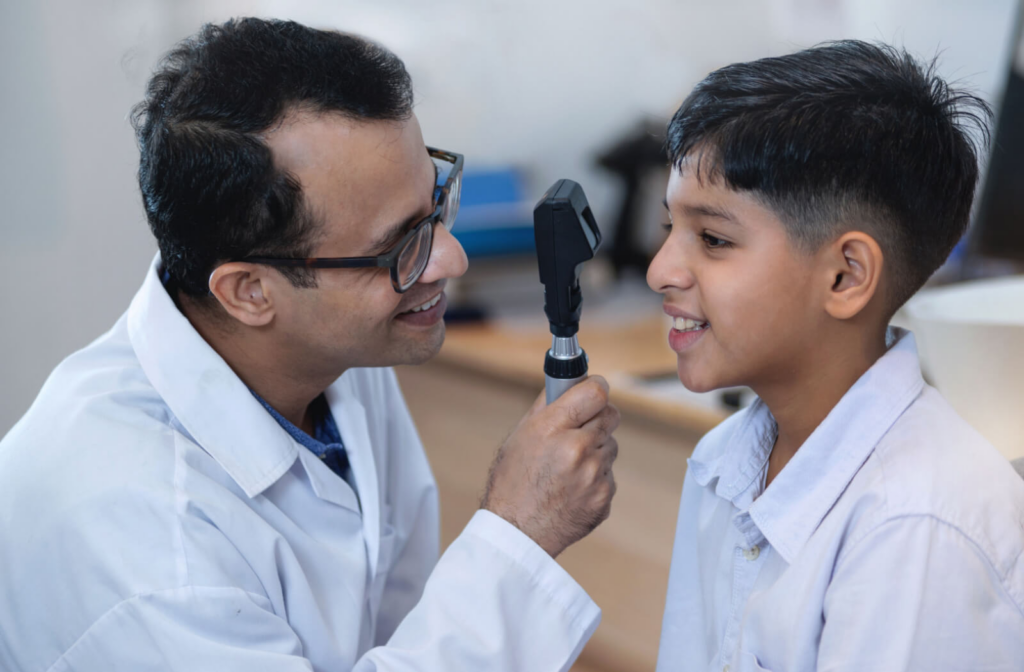Table of Contents

Introduction
In your child’s classroom, you may notice more eyeglass wearers than ever, and that’s because myopia, or nearsightedness, is affecting more and more children. Your child’s eyes are growing and changing, making their annual eye exams crucial to detecting eye problems like myopia.
If your child’s teacher notices your child struggling to see the board at the front of the class or they’re sitting too close to the television, tablet, or computer screens at home, it’s best to visit your optometry team for a children’s eye exam and discuss myopia control techniques.
Atropine eye drops are a simple method of myopia control that can help slow the progression of nearsightedness. By minimizing its advancement, we can help prevent eye conditions related to high myopia, including retinal detachment, myopic macular degeneration, cataracts, or glaucoma. While there’s no way to reverse myopia, we can help to treat and control it.
What Is Myopia Control?
With the rising rate of myopia cases in children, controlling myopia progression is critical to prevent children from entering adulthood with high myopia, opening them up to more significant eye health risks.
While there seems to be a genetic link to myopia, where children have an increased chance of being nearsighted if a parent is, several lifestyle risk factors can contribute to the growing number of myopia sufferers. If both parents have myopia, there is 1 in 2 chance their kid will have myopia. Even if neither parent has myopia, there is still 1 in 4 chance their child will need nearsighted glasses.
Children who perform primarily in nearsighted tasks and activities like reading, writing, computer work, or close-up hobbies like art and handiwork can increase the likelihood of developing myopia. Some other risk factors include:
- Vision strain
- Overuse of screens and digital devices
- Less time spent outdoors
- Medical conditions
Controlling myopia with techniques like atropine eye drops can help prevent significant vision issues in later life.
Slow vs. Fast Myopia Progression with Axial Length Measurement
Monitoring your child’s eyes for myopia progression helps us develop a personalized treatment plan. While myopia advancement follows a general cycle, not all myopia is the same. Your child’s eyes are unique, so monitoring more frequently during younger growing years and taking precise measurements of their axial length can help chart their individual myopia progression and treatment.
Myopia is caused by an elongated eyeball that affects how light entering the eye is focused on the retina. The axial length is the measurement of the eye from front to back, and charting the change in size allows us to design an individualized treatment plan based on your child’s eye growth rate.
Axial length measurement is a highly precise dimension that can detect minor growth in the eye and offers information about the risks of certain eye diseases due to myopia. Taking axial measurements frequently provides insight into the entirety of your child’s eye health. Slowing down axial growth is the primary goal of myopia control.
Normal axial length in children changes over time, depending on their age.
- 0.1 to 0.2mm per year is expected for school-aged children and slows as they get older
- Normal eye growth stops at approximately 23mm or 23.5mm, depending on biological sex.
- An axial length of over 24mm indicates myopia, and if it measures beyond 26mm, it can increase the risk of future vision problems in later life.
Some eye growth stops around age 12, but those with myopia can experience eye growth into their late 20s and stabilize at an axial length beyond 25.5mm. Factors contributing to the variation between eye growth include gender, age, ethnicity, and lifestyle.
By tracking your child’s eye growth to build their treatment plan, our eye care team can help maximize the results of their myopia control treatments.

Atropine for Myopia Control
Atropine eye drops have many uses, from high doses to dilate eyes to lower concentrations for myopia control. A full dose of 1% atropine can inhibit the eye’s focusing mechanism for eye exams, treat amblyopia or lazy eye, or manage eye diseases.
The concentration of atropine can be adjusted to suit the treatment, but for myopia control in children, studies have shown that 0.02% atropine has the greatest effect.
While 1% atropine concentrations have been used in slowing myopia progression, lower doses are proving more effective with fewer side effects. In children between the ages of 4 and 14, 0.02% atropine has been shown to slow myopia progression by one-third after use for 2 to 3 years.
Depending on your child’s individualized treatment plan, their atropine eye drops will be carefully compounded for their needs, using saline or other sterile solutions to dilute from 1% atropine.
Nightly eye drops are a simple, safe, and effective method for myopia control. Your child may need corrective lenses to correct existing nearsightedness alongside atropine drops. Still, thoroughly assessing your child’s eyes, axial length, and projected myopia development will factor into their treatment plan to give them the best outcomes possible.
Start Myopia Control Early
If you or your child’s other family members have myopia, mention this history to our eye care team. Even when your child isn’t showing signs of nearsightedness, and they have no complaints about their vision, a comprehensive eye exam allows us to take axial length measurements early and begin tracking their eye growth to detect the first signs of myopia for early intervention.
Visit our dedicated myopia-fighting team at Golden Vision today to start protecting your child’s eyes early and start their ocular health journey off right.

